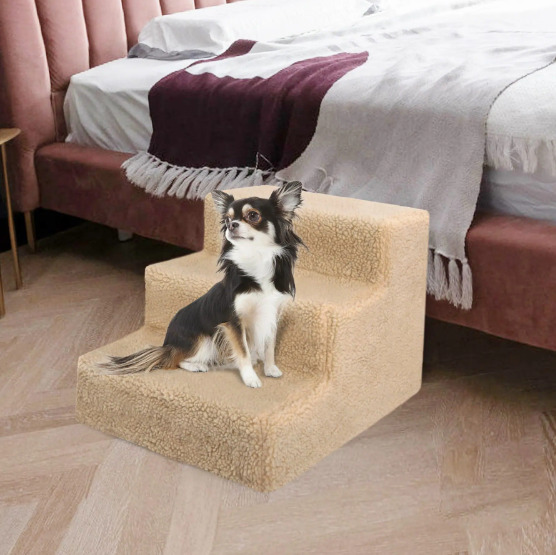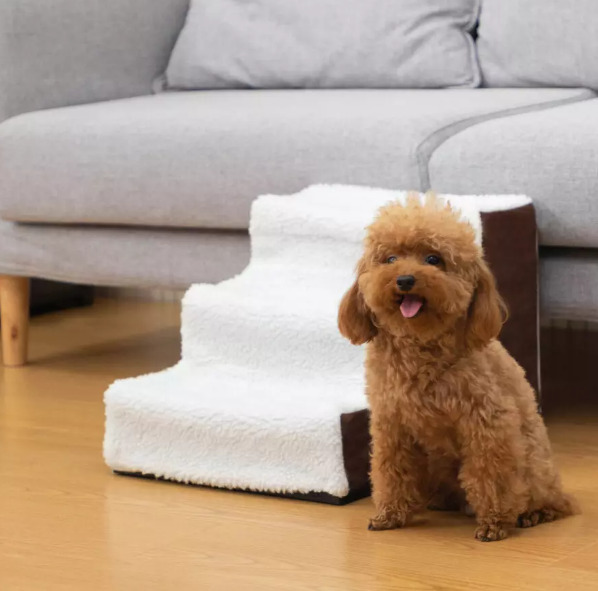When you have a furry friend at home, ensuring that they can easily access your bed or the couch is essential. This is particularly important when you have a small puppy or an older dog with mobility issues. Inappropriate jumping can lead to health problems in dogs. Hence, training your dog to use dog stair is a valuable skill. In this guide, we’ll walk you through the steps to train your dog to use pet steps for their safety and comfort.
Understanding Why Dog Stair Is Necessary
Before diving into the training process, it’s crucial to understand why using dog stair is necessary for your pet.
Joint Health Protection
Dogs, especially puppies and older ones, are susceptible to joint issues such as hip dysplasia and arthritis. These conditions can be exacerbated by repetitive jumping on and off furniture. When a dog lands after a jump, it experiences significant impact forces on its joints, particularly the hips and knees. Over time, this can lead to joint pain, inflammation, and long-term damage. Dog stair offers a gradual and less strenuous way for dogs to reach elevated surfaces, reducing the strain on their joints and safeguarding their joint health.
Independence
Dogs are naturally curious and independent animals. By teaching your dog to use pet steps, you empower them to access their favorite spots independently. This newfound autonomy not only boosts their confidence but also relieves you from having to lift or assist your dog every time they want to join you on the couch or bed.
Reduced Injury Risk
Jumping on and off furniture can pose significant risks to your dog’s physical safety. Small or fragile dogs can easily miss their landing, leading to painful falls or injuries. Even larger dogs may not always land gracefully, increasing the likelihood of sprains or muscle strains. Using dog stair significantly reduces these risks, as they provide a secure and controlled way for your dog to ascend and descend from elevated surfaces.
Choose the Right Dog Stair
Size and Weight Capacity
The first consideration is the size and weight capacity of the dog stair. Ensure that the stairs you choose can comfortably accommodate your dog’s size and weight. Most pet steps come with weight guidelines, so make sure to check the manufacturer’s recommendations. Opt for a sturdy and stable set of stairs that won’t wobble or collapse when your dog uses them.
Material and Durability
Dog stair is available in various materials, including wood, plastic, and foam. Consider the material that best suits your dog’s needs and your home’s décor. Ensure that the stairs are well-constructed and durable to withstand your dog’s usage over time.
Ease of Cleaning
Dogs can track dirt and fur onto the stairs, so choose pet step that is easy to clean. Removable, machine-washable covers or wipeable surfaces can make maintenance a breeze.

Familiarize Your Dog with Dog Stair
Before formal training begins, introduce your dog to the dog stair. Place the stairs near the furniture and let your dog explore them freely. You can use treats or their favorite toys to entice them to approach the stairs, gradually making them comfortable with the new addition.
Utilize Positive Reinforcement Training
Positive reinforcement training is one of the most effective methods to teach your dog to use pet steps. Here are the steps to help your dog learn.
Step 1: Guiding Your Dog Up the Stairs
Start by using treats or toys to guide your dog up the stairs. Stand beside the stairs and place the rewards on the steps, encouraging your dog to climb up.
As your dog successfully climbs the dog stair, reward them immediately. Use praise and additional treats to motivate them.
Step 2: Establishing a Cue
Once your dog can comfortably climb the dog stair lift, start associating a cue word like “Upstairs” with the action. Use this word every time you guide your dog up the stairs so they begin to understand when to use the stairs.
Step 3: Practice and Repetition
Training takes time and patience. Practice multiple times a day until your dog can confidently ascend and descend the stairs independently.
Step 4: Gradually Increase Difficulty
After your dog masters the basics, gradually increase the difficulty. Add some distance between the dog stair and the furniture or introduce small obstacles on the stairs to mimic real-life situations.
Create Positive Experiences with Dog Stair
Ensure that using dog stair is a positive experience for your dog. Avoid punitive methods like shouting or physical punishment, as these can lead to fear or anxiety. Instead, focus on rewards and encouragement to create a positive association with the stairs.

Maintain Consistency
Consistency is key during the training process. Ensure that all family members use the same cue word and training methods to prevent confusion for your dog.
Supervise and Ensure Safety
Even after successful training, it’s essential to supervise your dog’s behavior, especially in the initial stages. Make sure they’re not attempting to jump onto furniture, which could still pose a risk to their joint health.
Additionally, regularly inspect the dog stair to ensure stability and structure. Check for any loose or damaged parts to maintain a safe environment for your dog.
Training your dog to use dog stair is a beneficial skill that can protect their joint health and promote independence. By employing positive reinforcement training methods, fostering positive experiences, and maintaining consistency, you can teach your dog to use pet steps effectively. Remember to be patient and provide plenty of rewards and encouragement throughout the training process. Most importantly, continue to supervise your dog and ensure their safety when using dog stairs around your home.